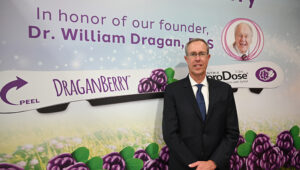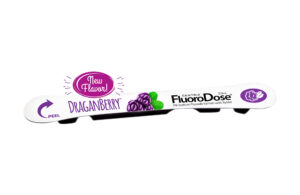Help Your Patients Start the School Year with a Smile!

The new school year is just around the corner! In a few weeks, children’s schedules will start to fill with various school and after-school activities. Between rushed breakfasts to catch the school bus, vending machine snacks at lunch, and quick dinners between soccer practice and homework time, it’s easy for kids to forget about brushing and flossing their teeth. This leaves plenty of opportunities for dental bacteria to develop. It is well known that caries and premature tooth loss negatively affect the child’s learning, development, and self-esteem. As children go back to school, it is crucial for them to feel confident and ready to learn; healthy teeth and gums help young students achieve their full potential. The good news is that with the right prevention protocol, you can ensure your pediatric patients maintain a healthy smile not only now but throughout their lifetime!
Alejandra Snyder, RDH, BSDH discusses how early care of dentition, starting with primary teeth, can influence a healthy development for permanent teeth; and how parent and caregiver education in child dentition care is essential to oral disease prevention in school-age children.
Parents and other caregivers for pediatric patients may not realize the contribution that primary teeth have in their child’s overall development. Primary teeth (also called deciduous teeth) play a very significant role in an individual’s life. This set of dentition is important for speech development and for eating and chewing nutrients which, in turn, help in arch development. In addition, primary teeth aid in keeping space available for the future eruption of permanent teeth. Moreover, the unaesthetic nature of untreated dental decay compromises the child’s self-esteem and social development.1 Primary teeth are susceptible to decay as soon as they erupt in the mouth; hence dental professionals need to educate parents on prevention of oral disease.
Dental caries is currently the most common chronic childhood disease in the United States.2 The American Academy of Pediatric Dentistry (AAPD) recognizes early childhood decay as a public health problem and encourages dental health care professionals to work closely with parents and medical professionals to ensure our children get proper care including nutritional counseling, dental screenings, and preventive care.3 AAPD also recommends that children receive their first dental examination by age one or within six months of their first tooth erupting.4
Therapeutic agents, such as topical fluoride and sealants, along with regular preventative visits to the dentist, aid in reducing the risk of tooth decay for infants and children.5 The American Dental Association recommends the application of fluoride varnish every three to six months for patients at high risk of developing caries. Fluoride varnish is 5% sodium fluoride (NaF) suspended in a colophonium resin which contains 22,600 ppm fluoride. Because of its sticky consistency, it adheres to the teeth surfaces for several hours allowing for maximum fluoride uptake. It also represents low risk of experiencing harm of swallowing in children younger than 6 years. Therefore, only doses of 2.26 percent fluoride varnish are recommended for this age group. The guidelines also state the benefit of 2.26 percent fluoride varnish in the permanent teeth of children aged 6 through 18 years, endorsing the use of this percentage of fluoride varnish for this age group for both coronal and root caries.6
FluoroDose fluoride varnish, from Centrix, has a proven record of efficacy and comes packaged in a convenient single-use LolliPack®, containing the perfect amount of fluoride (0.3mL). Each unit includes one Benda® Brush applicator which allows clinicians to easily apply the varnish. It is easy to use and infection control regulated. The consistency is smooth and dries in seconds upon contact with saliva without forming clumps. It has high patient acceptance due to its ability to stay clear on teeth surfaces and it comes in five pleasant flavors. This product is the top Fluoride Varnish from 2015-2019 according to THE DENTAL ADVISOR.7
Dental sealants are also effective in caries prevention. The 2016 panel for The American Dental Association Council on Scientific Affairs and the American Academy of Pediatric Dentistry (AAPD) established recommendations for the use of pit-and-fissure sealants. These guidelines state that sealants are effective in preventing and arresting pit and fissure occlusal caries lesions of primary and permanent molars in children and adolescents compared to the non-use of sealants. Also, sealants minimize the progression of non-cavitated occlusal caries lesions (also referred to as incipient lesions) of the tooth that received the sealant.8
Champ® pit and fissure sealant material, from Centrix, is packaged in single doses of 0.25mL and each dose includes a brush applicator. It is light-activated and does not require a bonding agent – simply etch, rinse, apply, and cure. It is easier to use than conventional syringe packaged sealants, since the brush allows for the material to go into every pit and fissure for homogeneous coverage, reducing the need to adjust the patient’s bite after curing. Champ utilizes a moisture-tolerant chemistry that seals out micro-leakage.9
Caries and premature loss of primary teeth can influence speech, learning, nutrition, self-esteem and overall development. By significantly reducing caries rates, oral health professionals can help improve their patients’ health. Parent/caregiver education on preventive measures to decrease oral disease such as diet, hygiene habits, fluoride application, and use of sealants are the most effective strategies to help younger patients achieve optimum oral care.
Try FluoroDose, our award-winning fluoride varnish loved by pediatric patients for its great taste and feel; and Champ, our easy-to-use bioactive, resin-based hydrophilic sealant with convenient packaging that allows you to choose the right delivery format for you and your patient.
To learn more about Prevention for Life®, our program to combat caries at any, age with the appropriate risk assessment tools to help you gain patient (and parent) acceptance, visit our prevention-focused website!
1. The Consequences of Untreated Dental Disease in Children. The California Society of Pediatric Dentistry. Retrieved April 2, 2017, from http://www.cda.org/Portals/0/pdfs/untreated_disease.pdf
2. Centers for Disease Control and Prevention. Children’s Oral Health. Available at: https://www.cdc.gov/oralhealth/children_adults/child.htm. Accessed February 1, 2017.
3. American Academy on Pediatric Dentistry Council on Clinical Affairs. Policy on early childhood caries (ECC): classifications, consequences, and preventive strategies. Pediatr Dent. 2008-2009;30(7 Suppl):40-3.
4. American Academy of Pediatric Dentistry. Policy on the Dental Home. Pediatr Dent. 2013;35(Suppl):24Ð25.
5. Moyer, V. A., , MPH. (2014). Prevention of Dental Caries in Children From Birth Through Age 5 Years: US Preventive Services Task Force Recommendation Statement. Pediatrics, 2014(133), 1102nd ser., 1102-1103.
Retrieved April 2, 2017.
6. Weyant RJ, Tracy SL, Anselmo T, et al. Topical fluoride for caries prevention: Executive summary of the updated clinical recommendations and supporting systematic review. J Am Dent Assoc. 2013; 144:1279Ð1291.
7. Centrix. FluoroDose. Available at: https://www.centrixdental.com/fluorodose.html. Accessed January 20, 2017.
8. Wright J, Crall J, Fontana M, et al. Evidence-based clinical practice guidelines for the use of pit-and-fissure sealants. J Am Dent Assoc. 2016;147: 672Ð682.
9. Centrix. Champ. Available at: https://www.centrixdental.com/champ.html. Accessed January 23, 2017.
Photo credit: Schoolboy photo created by pressfoto – www.freepik.com
Boost Your Expertise with Our Lunch & Learn Programs!
Join our engaging Lunch & Learn sessions and take your dental skills to the next level. Enjoy a meal while learning from experts about evidence-based solutions, caries prevention, restorative procedures, and more. Enhance your practice and patient outcomes with our comprehensive courses.
Share
You Might Also Like...

Centrix President Discusses How the Company Became a Prevention Leader!
Prominent Polish dental magazine, Twój Przegląd Stomatologiczny, interviewed William to get the inside scoop on the interesting history of Centrix and our efforts to make prevention easier.

Introducing the NEW flavor of FluoroDose fluoride varnish … DraganBerry!
In honor of Dr. Dragan’s achievements, Centrix has introduced a magical new flavor of FluoroDose fluoride varnish — DraganBerry.

The Most Minimally Invasive Way to Treat Decay
Did you know that combining silver diamine fluoride (SDF) with the application of glass ionomer can be a long-term solution for restoring a badly decayed tooth to its full strength and glory?


